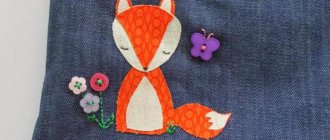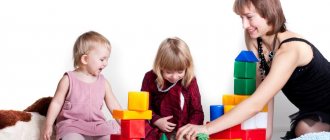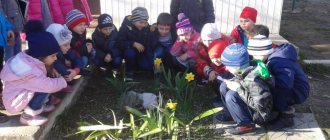Card index of creative games for preschool children
Card index of creative games
for younger ages.
«Toys at the doctor"
Target:
teach children how to care for the sick and use medical instruments, cultivate attentiveness and sensitivity in children, expand their vocabulary: introduce the concepts of “hospital”, “patient”, “treatment”, “medicines”, “temperature”, “hospital”.
Equipment:
dolls, toy animals, medical instruments: thermometer, syringe, pills, spoon, phonendoscope, cotton wool, jars of medicine, bandage, robe and doctor’s cap.
Progress of the game:
The teacher offers to play, a Doctor and a Nurse are selected, the rest of the children pick up toy animals and dolls and come to the clinic for an appointment. Patients with various diseases turn to the doctor: the bear has toothache because he ate a lot of sweets, the doll Masha pinched her finger in the door, etc. We clarify the actions: The doctor examines the patient, prescribes treatment for him, and the Nurse follows his instructions. Some patients require inpatient treatment and are admitted to hospital
"Building a house"
Target:
introduce children to construction professions, pay attention to the role of equipment that facilitates the work of builders, teach children how to build a simple structure, cultivate friendly relationships in a team, expand children’s knowledge about the peculiarities of the work of builders, expand children’s vocabulary: introduce the concepts of “construction”, “bricklayer” ", "crane", "builder", "crane operator", "carpenter", "welder", "building material".
Equipment:
large building material, cars, a crane, toys for playing with the building, pictures depicting people in the construction profession: mason, carpenter, crane operator, driver, etc.
Progress of the game:
The teacher invites the children to guess the riddle: “What kind of turret is there, and is there a light in the window? We live in this tower, and it's called...? (house)". The teacher invites the children to build a large, spacious house where toys can live. Children remember what construction professions there are, what people do at a construction site. They look at pictures of construction workers and talk about their responsibilities. Then the children agree to build a house. Roles are distributed among the children: some are Builders, they build a house; others are Drivers, they transport building materials to a construction site, one of the children is a Crane Operator. During construction, attention should be paid to the relationships between children.
"Stepashka's Birthday"
Target:
expand children's knowledge about the methods and sequence of table setting for a festive dinner; consolidate knowledge about cutlery, cultivate attentiveness, caring, responsibility, desire to help; expand your vocabulary: introduce the concepts of “celebratory dinner”, “name day”, “serving”, “dishes”, “service”.
Equipment:
toys that can come to visit Stepashka, tableware - plates, forks, spoons, knives, cups, saucers, napkins, tablecloth, table, chairs.
Progress of the game:
The teacher informs the children that today is Stepashka’s birthday and offers to go visit him and congratulate him. The children take their toys, go to visit Stepashka and congratulate him. Stepashka offers everyone tea and cake and asks them to help him set the table. Children actively participate in this and, with the help of the teacher, set the table. during the game
"Let's go for a walk"
Target:
develop in children the ability to select clothes for different seasons, teach them to correctly name items of clothing, consolidate the general concepts of “clothing”, “shoes”, and cultivate a caring attitude towards others.
Equipment: dolls, clothes for all seasons (summer, winter, spring and autumn, a small wardrobe and a chair.
Progress of the game:
A new doll comes to visit the children. She meets them and wants to play. But the guys are going for a walk and invite the doll to go with them. The doll complains that she can’t get dressed, and then the guys offer her their help. Children take out doll clothes from the locker, name them, choose what they need to wear now depending on the weather. With the help of the teacher, they dress the doll in the correct sequence. Then the children dress themselves and go out for a walk with the doll. Upon returning from a walk, the children undress themselves and undress the doll in the required sequence, commenting on their actions
"Doll's Birthday"
Goals : introduce children to the rules of table setting, table manners, and tableware; teach how to correctly find and select utensils for tea drinking;
continue to enrich the content of games; promote the unification of children for joint games; enrich vocabulary; cultivate a desire to observe norms of behavior at the table, respectful attitude towards each other.
Equipment: teaware, tablecloth, doll in an elegant dress, figurative toys (bear, hare, barrel of honey, carrot. You can use substitute items.
Progress of the game:
The teacher says that today is Katya’s doll’s birthday and she invites you to visit. Advises the children to think about what they will give Katya, how they will please her. He suggests that they can come to visit with a bear and bring a barrel of honey or with a bunny who will give Katya a delicious sweet carrot.
Then the teacher invites the children to help Katya beautifully set the table for the guests and prepare tea.
Children are going to a birthday party.
When repeating the game, you can celebrate the birthday of a bear, bunny, cat, etc.
Card index of creative games for middle-aged children.
Zoo
Target:
expand children's knowledge about wild animals, their habits, lifestyle, nutrition, cultivate love and humane attitude towards animals, expand children's vocabulary.
Equipment:
toy wild animals familiar to children, cages (made of building material), tickets, money, cash register.
Progress of the game
: The teacher tells the children that a zoo has arrived in town and offers to go there. Children buy tickets at the box office and go to the zoo. There they look at the animals, talk about where they live and what they eat. During the game, children should pay attention to how to treat animals and how to care for them.
Target:
introduce children to construction professions, pay attention to the role of equipment that facilitates the work of builders, teach children how to build a simple structure, cultivate friendly relationships in a team, expand children’s knowledge about the peculiarities of the work of builders, expand children’s vocabulary: introduce the concepts of “construction”, “bricklayer” ", "crane", "builder", "crane operator", "carpenter", "welder", "building material".
We are building a house
Equipment:
large building material, cars, a crane, toys for playing with the building, pictures depicting people in the construction profession: mason, carpenter, crane operator, driver, etc.
Progress of the game
: The teacher invites the children to guess the riddle: “What kind of turret is there, and is there a light in the window? We live in this tower, and it's called...? (house)". The teacher invites the children to build a large, spacious house where toys can live. Children remember what construction professions there are, what people do at a construction site. They look at pictures of construction workers and talk about their responsibilities. Then the children agree to build a house. Roles are distributed among the children: some are Builders, they build a house; others are Drivers, they transport building materials to a construction site, one of the children is a Crane Operator. During construction, attention should be paid to the relationships between children. The house is ready and new residents can move in. Children play independently.
Kindergarten
Target:
to expand children’s knowledge about the purpose of a kindergarten, about the professions of those people who work here - a teacher, a nanny, a cook, a music worker, to instill in children a desire to imitate the actions of adults, and to treat their pupils with care.
Equipment:
all the toys you need to play in kindergarten.
Progress of the game:
The teacher invites the children to play in kindergarten. If desired, we assign children to the roles of Educator, Nanny, Music Director. Dolls and animals act as pupils. During the game, they monitor relationships with children and help them find a way out of difficult situations.
Shop
Target:
teach children to classify objects according to common characteristics, cultivate a sense of mutual assistance, expand children’s vocabulary: introduce the concepts of “toys”, “furniture”, “food”, “dishes”.
Equipment:
all toys depicting goods that can be bought in a store, located on the display window, are money.
Progress of the game
: The teacher invites the children to place a huge supermarket in a convenient place with departments such as vegetable, grocery, dairy, bakery and others where customers will go. Children independently distribute the roles of sellers, cashiers, sales workers in departments, sort goods into departments - groceries, fish, bakery products, meat, milk, household chemicals, etc. They come to the supermarket for shopping with their friends, choose a product, consult with sellers, pay at the cash register. During the game, the teacher needs to pay attention to the relationship between sellers and buyers. The older the children, the more departments and products there may be in the supermarket.
At the doctor's
Target
: teach children how to care for the sick and use medical instruments, cultivate attentiveness and sensitivity in children, expand their vocabulary: introduce the concepts of “hospital”, “patient”, “treatment”, “medicines”, “temperature”, “hospital”.
Equipment
: dolls, toy animals, medical instruments: thermometer, syringe, pills, spoon, phonendoscope, cotton wool, jars of medicine, bandage, robe and doctor’s cap.
Progress of the game
: the teacher offers to play, a Doctor and a Nurse are selected, the rest of the children pick up toy animals and dolls, and come to the clinic for an appointment. Patients with various diseases turn to the doctor: the bear has toothache because he ate a lot of sweets, the doll Masha pinched her finger in the door, etc. We clarify the actions: The doctor examines the patient, prescribes treatment for him, and the Nurse follows his instructions. Some patients require inpatient treatment and are admitted to the hospital. Children of older preschool age can choose several different specialists - a therapist, an ophthalmologist, a surgeon and other doctors known to children. When they get to the appointment, the toys tell them why they came to the doctor, the teacher discusses with the children whether this could have been avoided, and says that they need to take more care of their health. During the game, children watch how the doctor treats the sick - makes bandages, measures the temperature. The teacher evaluates how children communicate with each other.
Creative games for older kindergarten children
"Kindergarten".
Target:
Consolidating children's knowledge about the work of a nurse and doctor, laundress, cook, janitor and other kindergarten workers. Fostering interest and respect for their work. Developing in children a sense of gratitude for the work of adults for them, a desire to provide them with all possible help. Development of the ability to apply acquired knowledge in collective creative play.
Subject development environment (equipment):
Dolls, toy dishes, Doctor set, toy telephone, substitute items.
Preparing for the game.
Excursion to the doctor's office. Introducing attributes for organizing the game of “children’s doctor”. Reading the story “Our Doctor” by A. Kardashova. Observation of the work of a laundress. Organization of children's work - washing doll clothes. A tour of the kitchen. Lesson “Let’s bake buns for ourselves and the kids.” Modeling products for playing “cook”. Conversation “Who works in our kindergarten and how.” Drawing on this topic. Introducing attributes for organizing a collective game in the “kindergarten”.
Game roles.
Doctor, nurse, teacher, manager, music worker, assistant teacher (nanny), cook.
Progress of the game.
Before the game starts, the teacher carries out preliminary work. Together with the children, they visit the medical office, the kitchen, the laundry room, the rhythm room, the manager’s office and talk with the nurse and doctor, cook, laundress, and manager about their work.
After this, the teacher conducts a conversation in the group “Who works in our kindergarten and how”, and summarizes the knowledge gained on the excursion. Then you can play the game “Daily Routine” with the children, thereby outlining a game plan. You can also read stories and poems about kindergarten with your children and prepare the necessary attributes for the game: instruments for the doctor, doll dishes, etc. Next, the teacher can invite the children to play on their own, if the children have not yet developed a proper interest in the game, The teacher can act in the game as an equal partner, playing a major or minor role, indirectly influencing changes in the game environment, he can correct the game relationships. For example, he can offer children the following roles: “doctor”, “nurse”, “teacher”, “manager”, “music worker”, “teacher’s assistant”, “cook”. When all the roles have been distributed, the teacher encourages the children to play: “Now you need to do exercises with the dolls, then sit them down to have breakfast.” “Nanny needs to quickly go to the kitchen and bring breakfast.” “After breakfast, you need to go for a check-up with a doctor.” After breakfast, the “doctor” and “nurse” carefully examine the “children” and give each one recommendations. One child is sick and the “teacher” needs to call the parents on the phone: “Your daughter is sick, she needs to be picked up from kindergarten.” After a medical examination, the “children” need to go to a “music lesson,” etc. As the game progresses, the teacher monitors the correct development of the plot, smoothes out emerging conflicts, advises what else can be invented, and introduces new roles for the children if they wish.
Game "School".
Target.
Formation of the ability to creatively develop the plot of the game. Teaching children to fairly distribute roles in games. Encouraging children to reproduce in games the everyday and socially useful work of adults.
Subject development environment (equipment):
Dolls, furniture, building materials, play attributes (magazine, notebooks, pens, pencils), substitute items.
Preparing for the game.
Excursion to school. Conversation with a 1st grade teacher. Reading the works of L. Voronkova “Girlfriends Go to School” or E. Moshkovskaya “We Play School” and others. Joint games with children of the preparatory group.
Game roles
. Teacher, students.
Progress of the game.
Before the game starts, the teacher organizes a tour of the school. There the children meet teachers, schoolchildren, and talk with them. It is also necessary to take the children around the entire school: show them the classrooms, canteen, workshops, locker room, etc. Then, in a group, discuss their impressions of the school. Then, to further enrich knowledge about school, the teacher reads to the children the work of L. Voronkova “Girlfriends Go to School” (or E. Moshkovskaya “We Play School”, etc.). This is followed by a conversation about what it means to be a schoolchild, who teaches the lesson, what supplies the student has, etc. The teacher also helps children in mastering expressive means of playing a role (intonation, facial expressions, gestures). Together with the children, the teacher can make attributes for the game: a magazine for the teacher, headbands for the attendants, etc. During the game, when constructing a school building or classroom, the teacher develops the design creativity and ingenuity of children, encourages the construction of interconnected buildings (street, school, cultural park , bridge, underground passage); proposes to use auxiliary materials in buildings (cords, pegs, planks, cones, wire, etc.). The methods of managing this game are different: the teacher plays the role of “teacher”, talks with children about how they will play, joint construction of a school or class. The use of such techniques promotes children’s independent organization of games, where they act in accordance with their selective interests (conduct reading, physical education, and mathematics lessons). Acting as an equal partner or playing a major (minor) role, the teacher must indirectly influence changes in the gaming environment and correct gaming relationships. The teacher should also facilitate the reproduction of everyday and socially useful work of adults in games. To consolidate knowledge of the Rules of the Road (the road from home to school and back), to combine games that are similar in theme, creating the possibility of long-term collective games: “Family” - “School” - “Road to school” - “Trip around the city”.
Game "Atelier" House of Fashion"
Goals:
To develop the ability of children to divide into subgroups in accordance with the plot and, at the end of a given game action, to unite again into a single team. To cultivate respect for the work of a seamstress, fashion designer, cutter, to expand the idea that their work is collective, that the quality of the work of another depends on the conscientious work of one person. Develop the ability to apply knowledge of measurement methods in the game. Develop children's dialogical speech.
Example game actions:
· selection and discussion of the model with the fashion designer, selection of material;
· cutters take measurements and make a pattern; the receptionist places the order, determines the deadline for completing the order;
· the seamstress fulfills the order, tries on the product;
· the head of the studio monitors the execution of the order, resolves conflict situations when they arise;
· the cashier receives money for a completed order;
· Delivery service may be available.
Subject development environment (equipment):
sewing machines, fashion magazine, sewing tools (cm, threads, fabric samples, etc.), accessories, patterns, order forms, “mannequins”.
Both bad and good
Typically, children evaluate what is happening in two categories - “good” and “bad”. Invite him to evaluate unpleasant situations in life using these categories, let him find the positive in the situation. They lost a backpack with toys - now he has become more attentive and the parents will buy a new beautiful backpack. We were sick at home for a week, but we trained our immunity and also read four thick books. We arrived at the seaside, and it was raining there - we went to the cinema, rode horses.
We, adult optimists, are accustomed to seeing positive moments, but children should be trained in this.





